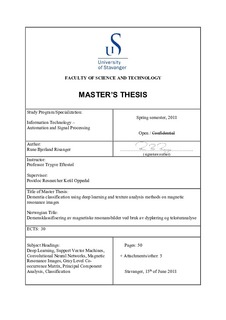| dc.contributor.advisor | Oppedal, Ketil | |
| dc.contributor.advisor | Eftestøl, Trygve | |
| dc.contributor.author | Risanger, Rune | |
| dc.date.accessioned | 2018-09-26T14:21:40Z | |
| dc.date.available | 2018-09-26T14:21:40Z | |
| dc.date.issued | 2018-06-15 | |
| dc.identifier.uri | http://hdl.handle.net/11250/2564811 | |
| dc.description | Master's thesis in Automation and signal processing | nb_NO |
| dc.description.abstract | Dementia is becoming an increasingly severe economical and socio-economical disease, as treatment is problematic, with different disease variants difficult to prevent and delay. With a rise in life expectancy, further problematic increase is expected to occur. Clinical diagnosis is difficult, with poor inter- and intra-rating between doctors. Developing tools for computer assisted diagnosis (CAD) for diagnosis verification could provide benefits for doctors and patients alike.
The primary objective of this thesis is to develop a CAD-system, to be implemented on T1-weighted magnetic resonance images (MRI) of normal controls (NC) and patients with either Alzheimer's dementia (AD) or Dementia with Lewy Bodies (DLB). Comparing results achieved through deep learning (DL) with texture analysis (TA) techniques together with Support Vector Machines (SVM) were also of importance. The CAD system was developed as a differential diagnosis system including all three groups in one classifier, but all binary classifications were also evaluated.
Results on a dataset of 760 subjects do not directly suggest if either method outperforms the other, with an achieved total accuracy of 66 % and 59 % for CNN- and SVM-classification respectively. Prior comparable studies have reported overall better accuracies on more shallow datasets, with results in this thesis suffering less on account of potential over-fitting issues. Limitations for DL-classification include dataset size and amount of evaluated architectures. The dataset could be expanded through availability of more study data or exploration of several data augmentation methods. Other potential limitations include lack of additional MR sequences or other modalities such as PET scans, with additional features possibly generating better results for the SVM-classifier. An enlarged dataset and additional TA methods could yield enhanced performance for CNN- and SVM-classifiers respectively. | nb_NO |
| dc.language.iso | eng | nb_NO |
| dc.publisher | University of Stavanger, Norway | nb_NO |
| dc.relation.ispartofseries | Masteroppgave/UIS-TN-IDE/2018; | |
| dc.rights | Navngivelse 4.0 Internasjonal | * |
| dc.rights.uri | http://creativecommons.org/licenses/by/4.0/deed.no | * |
| dc.subject | informasjonsteknologi | nb_NO |
| dc.subject | automatisering og signalbehandling | nb_NO |
| dc.subject | demens | nb_NO |
| dc.subject | MRI | nb_NO |
| dc.title | Dementia classification using deep learning and texture analysis methods on magnetic resonance images | nb_NO |
| dc.title.alternative | Demensklassifisering av magnetiske resonansbilder ved bruk av dyplæring og teksturanalyse | nb_NO |
| dc.type | Master thesis | nb_NO |
| dc.subject.nsi | VDP::Teknologi: 500::Informasjons- og kommunikasjonsteknologi: 550 | nb_NO |

